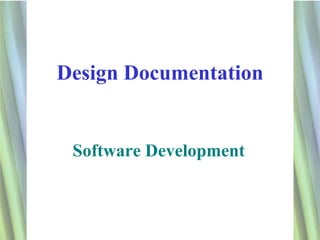
Software Design Documentation
- 1. Design Documentation Software Development 1
- 2. Software Development Lifecycle This is used by software designers - the whole design process can be thought of as a cycle The stages are: Identify - Define requirements and specification Design - Plan the solution to the problem Develop - Produce the program code Test - Locate and remove any errors Evaluate - Review against program requirements 2
- 3. Identify the Scope The first stage of the design process is based upon analysing the user’s requirements to determine what is achievable with the resources available. Resource limitations (called constraints) usually involve time and money. Prioritise the most important features and decide what will be included in the first version of the software and what can be left out and put on the ‘wish list’ for future versions. You then need to produce a formal written requirements specification for the program 3
- 4. Design Documentation Requirement Specification: Inputs are required from the user Outputs expected by the user Processing needed to provide functionality Constraints e.g. time, funds, specialist skills Screen Designs Program Design: Modules and Algorithms: Structure Diagram / Flowcharts / Pseudocode Data Dictionary Test Plan 4
- 5. Requirements Specification Inputs: List of all the data that is input by the user Give specific details of the actual data, e.g. first name and last name of user Identify valid and invalid values for text and acceptable ranges for numeric data Outputs: List of all output expected by the user Give specific details of the actual data and format, e.g. Monthly sales report which will be displayed in a bar chart, showing total sales for each product Include any help information e.g. Instructions, error messages or visual feedback 5
- 6. Requirements Specification Processing: Give details of all the functions the program will need to have. You should break this down into each processing task e.g. validation, calculations, formatting etc. Explain what each function should do (not how – yet!) There could be many of these in your proposed system Constraints: Identify any resource limitations It could include budget, development timescales, hardware available, training requirements, special needs of users etc. Give specific details of each, e.g. The total budget available is £50,000 6
- 7. Screen Designs Provide a storyboard to show screens at various stages of the program Draw them… Count Down On paper… In Word or Visio… In Visual Studio… They must show The prompts the user will see Example input Example output 7
- 8. Process Specification Requirements Specification - describes WHAT the system must be able to do. Process Specification - provides details of HOW the required functionality is achieved. Various techniques used to clarify procedures Flow Charts Structure Diagram Pseudocode / Structured English Provides the logical design for a computer algorithm Not language specific 8
- 9. Data Dictionary This is used to document the variables and data types used in your program Show the variable names, datatypes and a description of what data the variable is going to store Identify location e.g. Local or Global Remember local is better 9 9
- 10. A Data Dictionary Table with details of all important variables Variable DataType Description VAT Global Single, Constant Holds current VAT rate (17.5%) sngVATPrice Local to Single Holds price of goods Checkout inc VAT intQuantity Local to Integer Number of items Checkout 10